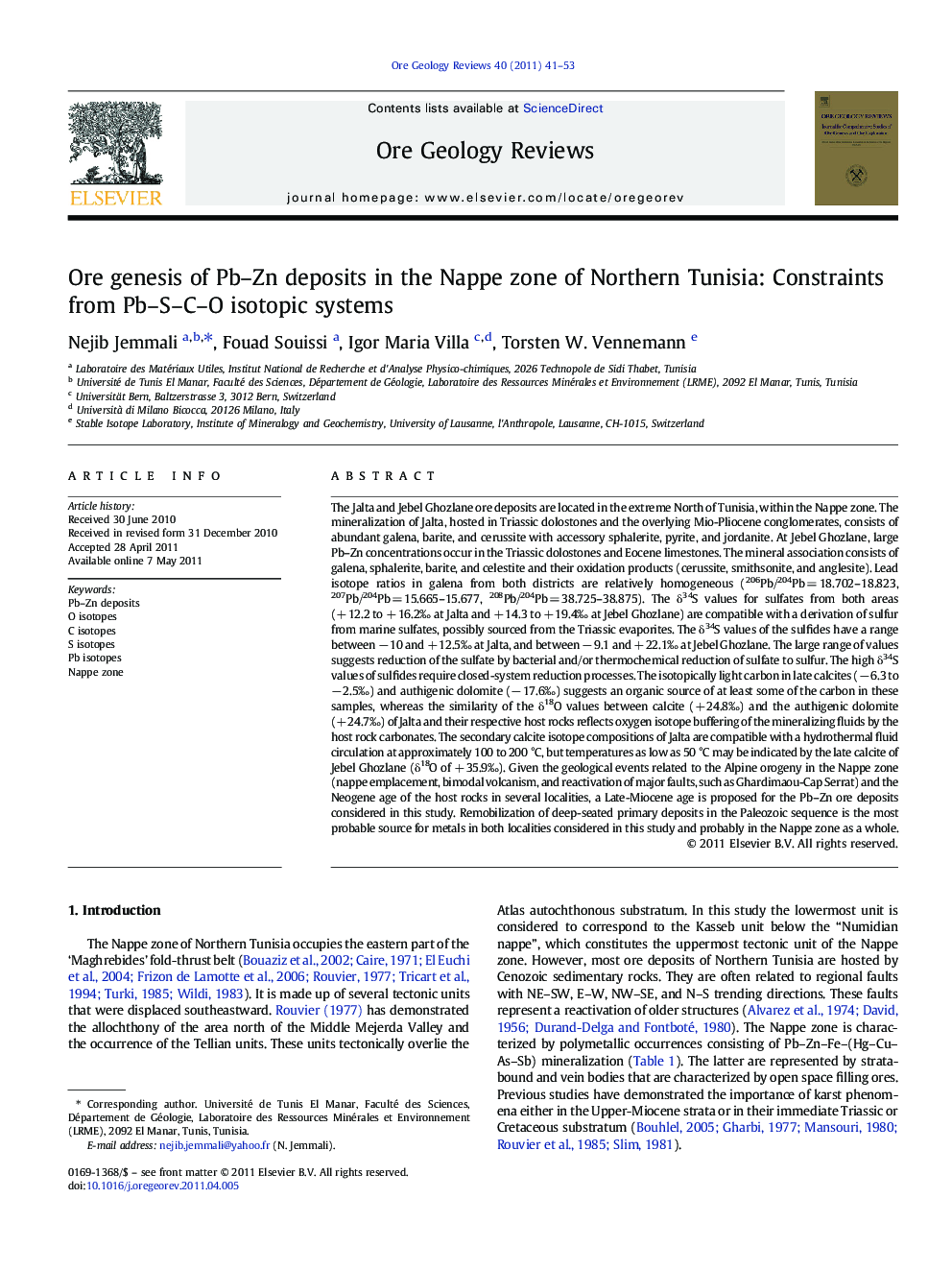| کد مقاله | کد نشریه | سال انتشار | مقاله انگلیسی | نسخه تمام متن |
|---|---|---|---|---|
| 4697718 | 1637260 | 2011 | 13 صفحه PDF | دانلود رایگان |

The Jalta and Jebel Ghozlane ore deposits are located in the extreme North of Tunisia, within the Nappe zone. The mineralization of Jalta, hosted in Triassic dolostones and the overlying Mio-Pliocene conglomerates, consists of abundant galena, barite, and cerussite with accessory sphalerite, pyrite, and jordanite. At Jebel Ghozlane, large Pb–Zn concentrations occur in the Triassic dolostones and Eocene limestones. The mineral association consists of galena, sphalerite, barite, and celestite and their oxidation products (cerussite, smithsonite, and anglesite). Lead isotope ratios in galena from both districts are relatively homogeneous (206Pb/204Pb = 18.702–18.823, 207Pb/204Pb = 15.665–15.677, 208Pb/204Pb = 38.725–38.875). The δ34S values for sulfates from both areas (+ 12.2 to + 16.2‰ at Jalta and + 14.3 to + 19.4‰ at Jebel Ghozlane) are compatible with a derivation of sulfur from marine sulfates, possibly sourced from the Triassic evaporites. The δ34S values of the sulfides have a range between − 10 and + 12.5‰ at Jalta, and between − 9.1 and + 22.1‰ at Jebel Ghozlane. The large range of values suggests reduction of the sulfate by bacterial and/or thermochemical reduction of sulfate to sulfur. The high δ34S values of sulfides require closed-system reduction processes. The isotopically light carbon in late calcites (− 6.3 to − 2.5‰) and authigenic dolomite (− 17.6‰) suggests an organic source of at least some of the carbon in these samples, whereas the similarity of the δ18O values between calcite (+ 24.8‰) and the authigenic dolomite (+ 24.7‰) of Jalta and their respective host rocks reflects oxygen isotope buffering of the mineralizing fluids by the host rock carbonates. The secondary calcite isotope compositions of Jalta are compatible with a hydrothermal fluid circulation at approximately 100 to 200 °C, but temperatures as low as 50 °C may be indicated by the late calcite of Jebel Ghozlane (δ18O of + 35.9‰). Given the geological events related to the Alpine orogeny in the Nappe zone (nappe emplacement, bimodal volcanism, and reactivation of major faults, such as Ghardimaou-Cap Serrat) and the Neogene age of the host rocks in several localities, a Late-Miocene age is proposed for the Pb–Zn ore deposits considered in this study. Remobilization of deep-seated primary deposits in the Paleozoic sequence is the most probable source for metals in both localities considered in this study and probably in the Nappe zone as a whole.
► Lead isotopes indicate one generation of fluids that interacted with a heterogeneous basement.
► Sulfur isotopes suggest that BSR and TSR processes are responsible for reduction of Triassic evaporate sulfates.
► Carbon isotopes suggest an organic source for the authigenic dolomite and late calcites.
► The δ18O values reflect a buffering of the mineralizing fluids by host rock carbonates.
► Late-Miocene remobilization of primary deposits from the Paleozoic sequence is the most probable source for metals.
Journal: Ore Geology Reviews - Volume 40, Issue 1, September 2011, Pages 41–53